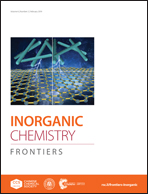Efficient bifunctional vanadium-doped Ni3S2 nanorod array for overall water splitting†
Abstract
Electrochemical water splitting, allowing energy conversion from renewable resources into non-polluting chemical fuels, is vital for future sustainable energy systems, and great efforts have been made for developing efficient and cheap bifunctional electrocatalysts. Herein we report a bifunctional vanadium-doped Ni3S2 nanorod array electrode for overall water splitting in alkaline media. To afford a catalytic current of 10 mA cm−2, the designed V-Ni3S2 electrode only requires overpotentials of 133 mV for hydrogen evolution and 148 mV for oxygen generation, meanwhile showing high long-term stability. The excellent catalytic properties are attributed to the V dopant and geometric advantages of the nanorod array. The V-Ni3S2 electrodes are simultaneously utilized as cathode and anode in one two-electrode cell for overall water splitting, exhibiting a cell voltage of 1.421 V at 10 mA cm−2. The water splitting in this cell can also be feasibly driven by a single-cell AA battery (1.5 V). Our report shows substantial advancement in the exploration of efficient bifunctional electrocatalysts for water splitting.



 Please wait while we load your content...
Please wait while we load your content...